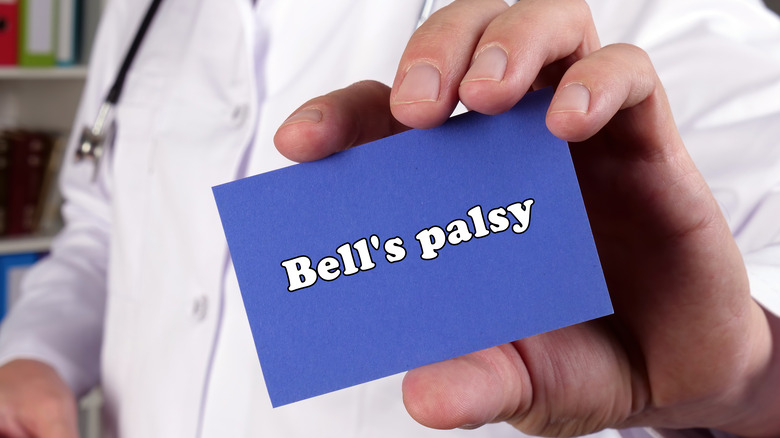When Should You See A Doctor For Bell's Palsy?
Bell's palsy is a sudden onset of weakness or paralysis on one side of the face. The causes of Bell's palsy aren't known, but doctors suspect that it's probably linked to viral infections — like those that cause shingles, cold sores, mononucleosis, sarcoidosis, or HIV — or bacterial infections like Lyme disease. The inflammation and swelling associated with these infections might put pressure on the facial nerve (which sits in a narrow bone canal known as the Fallopian canal), causing facial weakness or paralysis (per Healthline).
Being pregnant or having conditions like a respiratory infection, diabetes, high blood pressure, or obesity are risk factors, as stated by Mayo Clinic. It is thought that stress, illness, or physical trauma is capable of triggering dormant infections to wake back up and cause Bell's palsy (via Healthline).
But, what are the most common symptoms of Bell's palsy? And when would the presence of these telltale symptoms trigger you to seek out medical care?
Common symptoms of Bell's palsy
Cleveland Clinic states that facial paralysis caused by Bell's palsy usually occurs on one side, and the symptoms generally come on suddenly. Those affected often wake up in the morning with facial paralysis, per Healthline.
Sometimes, slight discomfort is felt behind the ear before weakness sets in, per Penn Medicine. This weakness can be mild or lead to complete immobility (via Mayo Clinic). On the weak side, the main symptoms include numbness or a feeling of heaviness, droopy mouth or drooling, and difficulty with facial expressions, such as frowning or smiling (via Healthline).
Healthline also notes that taste disturbances and hypersensitivity to sounds can occur in advance, in addition to difficulty eating and drinking. Within 48-72 hours, the facial paralysis peaks and is fully developed, according to Cleveland Clinic. Your facial nerve may take a while to heal, which can cause unusual facial movements due to damage to the nerve responsible for controlling the movement of the facial muscles, per Penn Medicine.
When to see a doctor for Bell's palsy
Facial paralysis is always a red flag and usually a medical emergency. Mayo Clinic notes that since a common stroke symptom is facial paralysis, rapid action is life-saving. So, you should take immediate action in the event that this occurs. Those affected should also always see a doctor if they experience temporary signs of paralysis on their face or if they feel numb. If Bell's palsy is found to be the cause, your physician might refer you to another doctor, such as a nerve specialist (neurologist).
The good news is that facial paralysis caused by Bell's palsy, in 80% of cases, is temporary and improvement begins from around 2 weeks to 3 months, according to Cleveland Clinic. Still, your doctor might prescribe prednisone, a corticosteroid that helps decrease swelling. Other treatment options include decompression surgery to release pressure from the nerve and functional facial plastic surgery for those who don't recover.



